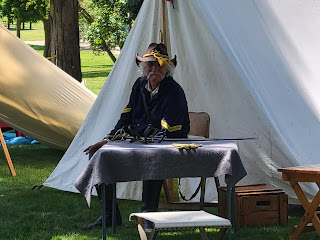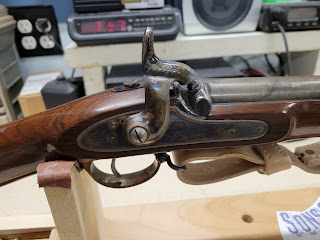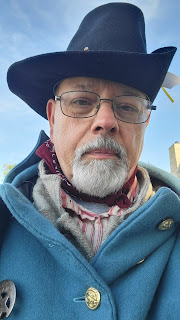Just passing this on from Bear Tooth Bill ( John Hoker). The National Congress of Old West Shootists is putt'n on an Old West Show & Sale! It's over by the Mississippi river in Davenport Iowa. See the flyer below, or check out their website at NCOWS.COM.
Gene Stevens
Central States Lawman and Outlaws Historic Assoc. In the late 1800s - and early 1900s The River of humanity flowing west, was both wide and deep. Caught in the current of manifest destiny, were settlers, soldiers, business interests, and Outlaws. It was a perfect whirlwind of the Wild west. G.C. Stevens
Tuesday, December 31, 2024
Old West Show 2025, National Congress Of Old West Shootists
Monday, December 23, 2024
Merry Christmas and Happy New Year
Merry Christmas and Happy New Year From the Central States Lawman and Outlaws Historic Assn.
(c) CSLOHA
All photos are in the public domain
Saturday, December 14, 2024
The John Wayne Birthplace and Museum
Thursday, December 5, 2024
Billy The Kid, The Controversies Live On.
Card From the Authors collection. Produced by the LL Cook Co.
The L.L. Cook Company was founded in 1921 and was one of the two largest postcard publishing companies in Milwaukee, Wisconsin up to the 1960s,
This is my first-ever article on Billy The Kid. I've written quite a bit about the intrigue in Tombstone AZ in the 1880s, and the gut wrenching story of Jesse and Frank James and their unfortunate but adventurous lives. But the story of Billy The Kid, is very different, unlike the stories of Wyatt Earp and Tombstone, which was in many ways, like a game of chess, and the Story of Jesse and Frank James was a matter of family bloodlines and the civil war. Billy's story is almost melancholy in nature, and one can find an easy connection to Henry and his circumstances, because he was a young guy caught up in a bad situation.
BILLY THE KID
Billy the Kid, born Henry McCarty, is one of the most notorious outlaws of the American Old West, whose life story has been romanticized through countless books, films, and songs. Known for his youth, charm, and deadly gun skills, Billy's legend outgrew the young man himself, making him an enduring figure in American folklore.
He was born in New York City around 1859, Henry McCarty’s life was marked by hardship from the start. After his father's death (or disappearance), he moved with his mother, Catherine, to Indianapolis, then to Wichita, Kansas, and eventually to Santa Fe, New Mexico Territory. After his mother died of tuberculosis in 1874, he was left to fend for himself, leading him into a life of petty crime. Adopting the alias "William H. Bonney" or "Kid Antrim," he quickly escalated from small thefts to horse thievery and murder. His transformation into "Billy the Kid" was sealed during the Lincoln County War (1878-1879), a conflict that involved rival factions in New Mexico fighting for economic control. Billy sided with the Regulators, a group formed to counter the corruption of the "House" faction. His involvement in the war included the killing of Billy's fame grew not just from his criminal activities but from his daring escapes. After the conflict, he was captured but managed an audacious escape from jail in Lincoln, New Mexico, where he killed two deputies. This escape, among others, contributed to his legend as both cunning and dangerous.
Pat Garrett, a former friend turned lawman, was determined to capture Billy. In 1880, Garrett managed to arrest him, but Billy escaped yet again. However, his freedom was short-lived. On July 14, 1881, Garrett shot and killed Billy at Fort Sumner, ending the life of the 21-year-old (or possibly 19, as his exact age is debated) outlaw.
Billy the Kid's death might have ended his physical existence, but his legend was just beginning. Over the years, his image has transformed from a simple outlaw to a symbol of the Wild West's untamed spirit:
Billy has been the subject of numerous films, including "The Left Handed Gun" and "Young Guns." His story also inspired countless novels, songs, and even video games.
There are numerous myths surrounding Billy, including claims that he was left-handed (debunked by photo analysis showing his gun belt on his left side, indicating he was right-handed) and tales of surviving his reported death. Some claim that Billy faked his death, leading to sightings and stories well into the 20th century. His grave in Fort Sumner remains a tourist attraction, symbolizing his undying legend.
Billy the Kid represents the duality of the American frontier: a place where lawlessness could coexist with the pursuit of freedom. His story questions the nature of heroism, villainy, and the thin line between the two in the lawless landscapes of the Old West. Whether seen as a cold-blooded killer or a victim of circumstance, Billy the Kid's legacy continues to captivate the imagination, embodying the untamed spirit of an era long gone but forever etched in history.
Tuesday, December 3, 2024
Vignette's of The Civil War, A Tale of Christmas in the 1860s By O.J. Fargo
Civil War Christmas
Drawing by Thomas Nast
"Thomas Nast built upon this 19th-century persona when he began drawing Santa for Harper’s Weekly. He published his initial illustration of Santa Claus in his first year with the magazine. His January 3, 1863 cover depicted Santa Claus handing out presents to Union soldiers."
"I'm sorry to write,
Our ports are blockaded, and Santa, tonight,
Will hardly get down here; for if he should start,
The Yankees would get him unless he was smart,
They beat all the men in creation to run,
And if they could get him, they'd think it fine fun
To put him in prison and steal the nice toys
He started to bring to our girls and boys.
But try not to mind it - tell over your jokes -
Be gay and be cheerful, like other good folks;
For if you remember to be good and kind,
Old Santa next Christmas will bear it in mind."
-From the collection of
O.J. Fargo.
The Most Interesting Man In Tombstone Arizona, John Clum. By G.C. Stevens
John Clum: The Crusading Mayor of Tombstone
Early Life and Career
John Philip Clum was born on September 1, 1851, near Claverack, New York, into a family of German and Dutch descent. His early life was marked by education at Rutgers University, though financial difficulties led him to leave before graduation. His journey west began when he joined the U.S. Army Signal Corps and was assigned to Santa Fe, New Mexico, as a weather observer. This was the start of an adventurous life that would lead him to become one of the most notable figures in the Old West.
Apache Agent and Capture of Geronimo
In 1874, Clum was appointed as an Indian agent for the San Carlos Apache Reservation in Arizona, a role where he introduced innovative governance methods including the establishment of an Apache police force and court system. His most famous act during this tenure was the peaceful capture of the Apache leader Geronimo in 1877, making him the only agent to achieve this feat without bloodshed. This period of his life showcased his ability to negotiate and manage complex intercultural relations.
The Tombstone Epitaph and Mayoral Position
The discovery of silver in Tombstone, Arizona, in 1877, attracted Clum, who saw an opportunity to start a newspaper. On May 1, 1880, he launched "The Tombstone Epitaph," which quickly became a voice for law and order in the turbulent town. Clum's involvement in local politics led to his election as Mayor of Tombstone in 1881, under a new city charter. His administration was characterized by efforts to combat lawlessness and corruption, aligning himself with the town's reformist elements.
Friendship with Wyatt Earp and the Gunfight at the O.K. Corral
Clum's tenure as mayor coincided with one of Tombstone's most infamous events: the Gunfight at the O.K. Corral on October 26, 1881. As a supporter of the Earp brothers, Clum's newspaper defended the actions of Wyatt, Virgil, and Morgan Earp, along with Doc Holliday, in the shootout against the Clanton and McLaury brothers. His editorial stance made him a target of those who opposed the Earps, leading to an alleged assassination attempt on him in December 1881 when his stagecoach was attacked.
Later Years and Legacy
After leaving Tombstone in 1882, Clum's career took him to various postal service roles across the U.S., including a significant stint in Alaska where he helped expand postal services during the gold rush. He also worked as a lecturer for the Southern Pacific Railroad, sharing stories of his adventures in the West. His later years were spent in California, where he passed away on May 2, 1932. Clum's legacy is not only in his administrative and journalistic contributions but also in his portrayal in numerous films and TV series, reflecting his colorful life in the Wild West.
John Clum's story is one of courage, reform, and the spirit of the American frontier. His efforts in Tombstone to instill law and order during a time of chaos, his friendship with key historical figures, and his dedication to public service across different roles highlight a life lived with both adventure and purpose. His contributions to the narrative of the Old West remain a testament to his enduring impact on American history.
Saturday, November 30, 2024
Western Cinema, John Wayne and Ward Bond
Thursday, November 28, 2024
Happy Thanksgiving From The Central States Lawman and Outlaws Historic Association
Monday, November 25, 2024
The 2025 John Wayne Birthplace Celebration, By G.C. Stevens
Monday, November 18, 2024
Vignette's of The Civil War, By O.J. Fargo, Edited by G.C. Stevens
 |
| Mess Mates of the Army of The Southwest at Winterset Iowa Photo by the Author |
CLOTHING
Blue Glasses
No they were not a fashion statement. The blue (cobalt) lenses were to protect light sensitive eyes. The most common reason was morphine addiction, which was called "the soldiers malaise" by some. There were other conditions that also required patients to wear them too.
Breaking in Brogans
One poster talked about soaking shoes and walking in them to mold them to your feet. Yes, it will do that but you will shorten the life and ruin the suppleness. leading to problems with your feet. My suggestion (one of many, but what I learned from the Marines and much field experience): take new shoes, rub in mink oil thoroughly. let stand over night. wipe off excess in am - repeat next night. if you want apply silicon snow seal or similar rubbing in to seams well. if you have smooth side out brogans (like I as a well-dressed officer do) then polish.. this regime will keep natural oils in the leather ensuring suppleness.
Bummer
Modern myths. The US Army cap issued for non-dress purposes is called a forage cap. Today people often refer it as a bummer cap, associating it with Sherman's bummers. It was not so called during the war. The Confederate Army did not issue a copy of the US Army forage cap--the caps reenactors so often use are incorrect. In the early war many Southerners used what we call a McDowell Cap, made with the low peak or brim that covers the eyes. An example is the pre-war cap Stonewall Jackson wore. The issue Confederate cap, however, is a copy of the stiffened French Army kepi.
Repel Saber
The front rank goes to charge bayonets, guard against cavalry. The rear rank takes a half step forward, holds their muskets, bayonets fixed, over the heads of the front rank men, parallel to the line of men, barrels facing out and up, fingers do not curl over the stock or barrel. The bayonet should be to the left, butt to the right, musket held lengthwise over the heads of about four men. The muskets of the rear rank overlapping one another. You have to be careful not to stick your bayonet into the head of the fifth man on the left. This is to guard the heads of the front rank men's heads from saber cuts delivered by mounted opponent.
FOOD
Fried Sweet Potatoes
Parboil for 15 minutes 4 good-sized sweet potatoes and remove skins. Cut thick potatoes slices lengthwise, and fry in butter or Crisco. Serve with maple syrup.
Cornbread
1 egg-well beaten
1/2 cup sugar
1 tsp. salt
1 cup sour or buttermilk
1 tsp. soda
2 Tbsp. melted shortening
1 cup flour
1 cup corn meal
Beat egg, add sugar. Pour in milk to which soda has been added. Add dry ingredients, beat well, and add shortening. Pour into shallow pan. Bake in hot oven (400 degrees) for approximately 25 minutes. Serve warm with butter or with creamed chicken or any creamed meat.
Abscesses
Abscesses were the fourth most common reason why white union soldiers could not march or fight. Treatment was incision and drainage, using thread as a drain. Sometimes a “seton wound” was made by passing thread or wire through the skin into an abscess, creating a passage to drain the pus. The seton sometimes was left in place for the rest of the soldier’s life, depending on the location of the abscess. Of course, drainage was not done with sterile technique or materials, because the role of microscopic living particles in causing infection was unknown to the surgeons. It is remarkable therefore that of more than a hundred thousand abscesses, there were only 180 deaths reported in the Sickness and Mortality Reports for the entire war in white soldiers and of 6,000 in U.S.C.T., only 21 deaths.[40]
Scurvy
The arthritis of scurvy (scorbutic arthritis) occurs when foods containing vitamin C are not eaten and was the fifth most common reason soldiers could not march and fight. It causes bruising of the skin, but more importantly, painful bleeding into joints and under the periosteum (lining around bones), especially the knees, ankles and shins. Obviously a soldier so affected would not have been able to stand up, much less march. Surgeon General of the Union Army (April 1862 to August 1863) William Hammond described his findings in soldiers and its treatment:
“Scurvy was known to the ancients, cured, as at present, by the use of fresh vegetable food. [Those with scurvy have] swollen and discolored gums, bleeding patches of…blood, first upon the legs…; hardness and [a] permanent state of contraction of the muscles; …stiffness of the joints; …reopening of old ulcers and cicatrices [scars].… Stiff joints [should be] rubbed with a stimulating liniment and be forcibly extended and fixed by mechanical means (splints to straighten them).”[41]
Unfortunately much of the food of both armies was dehydrated or overcooked, destroying any naturally occurring vitamin C. Especially tragic was the finding of a study in 1940 that showed the Minimum Daily Requirement of vitamin C to be a measly 30 mg/day.
Conspicuous by their absence in the present writing, are details of the same diseases in the Confederate States Army (CSA). Sadly, when Richmond was burned at the end of the War, its medical records were lost almost in their entirety.
‘Blood marked their tracks’
Ogilvie Donaldson was 25 years old when he mustered in as a corporal in the 19th Iowa Infantry in August 1862. Hard battles and active campaigning would take a toll on him, of course, but his lack of shoes while a prisoner was probably his biggest challenge.
In September 1863, Donaldson was among about 200 men in his regiment captured at Stirling’s Plantation and sent to Camp Ford. News eventually arrived that the regi-ment and others there were to be exchanged. The men had marched through Shreveport on their way to Tyler, but now for the exchange they were heading back—again by foot. It was a 100-mile trek and few men had shoes or heavy coats as the November cold settled in. “Over the frozen rough road and through ice-bound streams, those barefooted and half-clad five hundred marched, leaving on many a spot of Texan soil drops of blood from bruised and swollen feet,” wrote one 19th Iowa man, adding, “The sun at midday thawing it out only enough to make a cold slush, then toward night freezing again.”
Most 19th Iowa POWs had to learn to live without their brogans.
When plans for an exchange at Shreveport fell through, Donaldson and the others had to spend the winter camped a few miles from the city, huddled in improvised huts. In March 1864, they returned to Camp Ford. While there, word came of another exchange. It was July, and instead of frozen ground, unbearable heat beat down on the weakened men as they tramped to Shreveport. “[T]he
hot dust and pebbles blistered our shoeless feet, while hickory leaves bound ’round our head served as hats…”
When they eventually reached New Orleans on July 24, a local paper reported: “[O]ur citizens were astonished by the apparitions of a regiment, the like of which certainly never marched through the streets of any Christian city. Hatless and shoeless, without shirts and even garments that decency forbids us to name….[A]s their bare feet pressed the sharp stones, the blood marked their tracks.”
Donaldson’s medical record read like an encyclopedia of gastrointestinal ailments, including diarrhea, dysentery, and the flux. Home in Iowa, though wracked by the effects of frostbite and scurvy, he returned to his life as a farmer. But his deepest wounds weren’t physical: For years he kept a pair of shoes in every room—a stark reminder that he would never again be without.
Rick Barram, a history teacher from Red Bluff, Calif., is the great-great-grandson of the 19th Iowa’s Ogilvie Donaldson. He has no plans to walk barefoot across Arkansas in solidarity with his Hawkeye ancestor.
Fire by drum
The companies form into line of battle and dress. The command "Prepare to fire by the drum" is given, and the men go to the ready position, at half-cock. the drummer beats "rum pum pum pum pum" and on the last beat, the line goes to full cock. The drummer again plays "rum pum pum pum pum" and on the last beat, the soldiers aim.The drummer then plays "Pum pum pum...pum" On the third beat, the whole line fires at once, and on the fourth, they recover arms. Unless an occasional Jonah forgets the times, or screws up for whatever reason, the result is a crisp volley, and the crowd is always impressed.
Monday, November 4, 2024
A Cowboy Prayer
Card from the authors collection (c)
Friday, October 25, 2024
WILD WEST; Doc Holliday's Common Law Wife, Big Nose Kate, aka Katherine Harony
Mary Katherine Horony Cummings (November 7, 1849 – November 2, 1940), better known as Big Nose Kate, was a Hungarian-born American outlaw, gambler, prostitute and longtime companion and common-law wife of Old West gambler and gunfighter Doc Holliday.
If There's any western celebrity that Hollywood has modified to fit various ideas and roles in the lives of Doc Holliday and the Wyatt Earp story, it's was the enigmatic "Big Nose Kate." However. Katherine did not get her nick-name because she had a big nose, she had actually earned that moniker because she had a tendency of sticking her nose in other people's business.
She has been described as "Tough, stubborn and fearless", She was apparently educated, but chose to work as a prostitute. Though during the time period, it made sense for many frontier women to take up the sex trade, for lack of other means to make a steady living on the open frontier. It may have also afforded Kate the independence to move freely from cow- town to cow- town. She is by all accounts, the only woman with whom Holliday was known to have had a relationship.
Hollywood Portrayals
There are two memorable Hollywood movies that gave Big Nose Kate the limelight, one was "The Gun Fight at The OK Corral" (1957) , The other movie is of course Tombstone. In the 1957 version Kate is played by actress Jo Van Fleet, who plays the part of Kate Fisher, (Big Nose Kate by another name?). In one scene, Kate, Seeing Doc , (played by the great actor Kirk Douglas), in a bar, follows Holliday tohis room, where a huge argument erupts between the two frontier hot-heads, all while Holliday throws knives at the door - nearly hitting her as she brings up Holliday's once-prominent family. This hot mix of deep sexuality and domestic violence story line reappears in the movie Tombstone, where Doc, played by actor Val Kilmer, is the obvious friend, lover and pugilist with Big Nose Kate played by actress Joanna Pacula, who does a great job of recreating Kate, Hungarian accent included.
Friday, October 18, 2024
Outlaw; George Shepherd, Confederate Guerilla, Highwayman, Burglar
Civil War Reenactments, Army of the Southwest 2024 Season Photos
Happy 250th Birthday America
Photo by Brian Perhne On this day on July 04 1776, America declared its independence from Great Britain. Be Americans. Let there be ...

Readers Favorites
-
Located between Des Moines Iowa and Omaha Nebraska, runs a lessor known historic roadway called "White Pole Road". The road is a v...
-
24, July 1933 The Bonnie and Clyde Dexfield Iowa Shootout It's been 92 years since Henry Ney, a resident of Dallas County Iowa, decid...


































































































